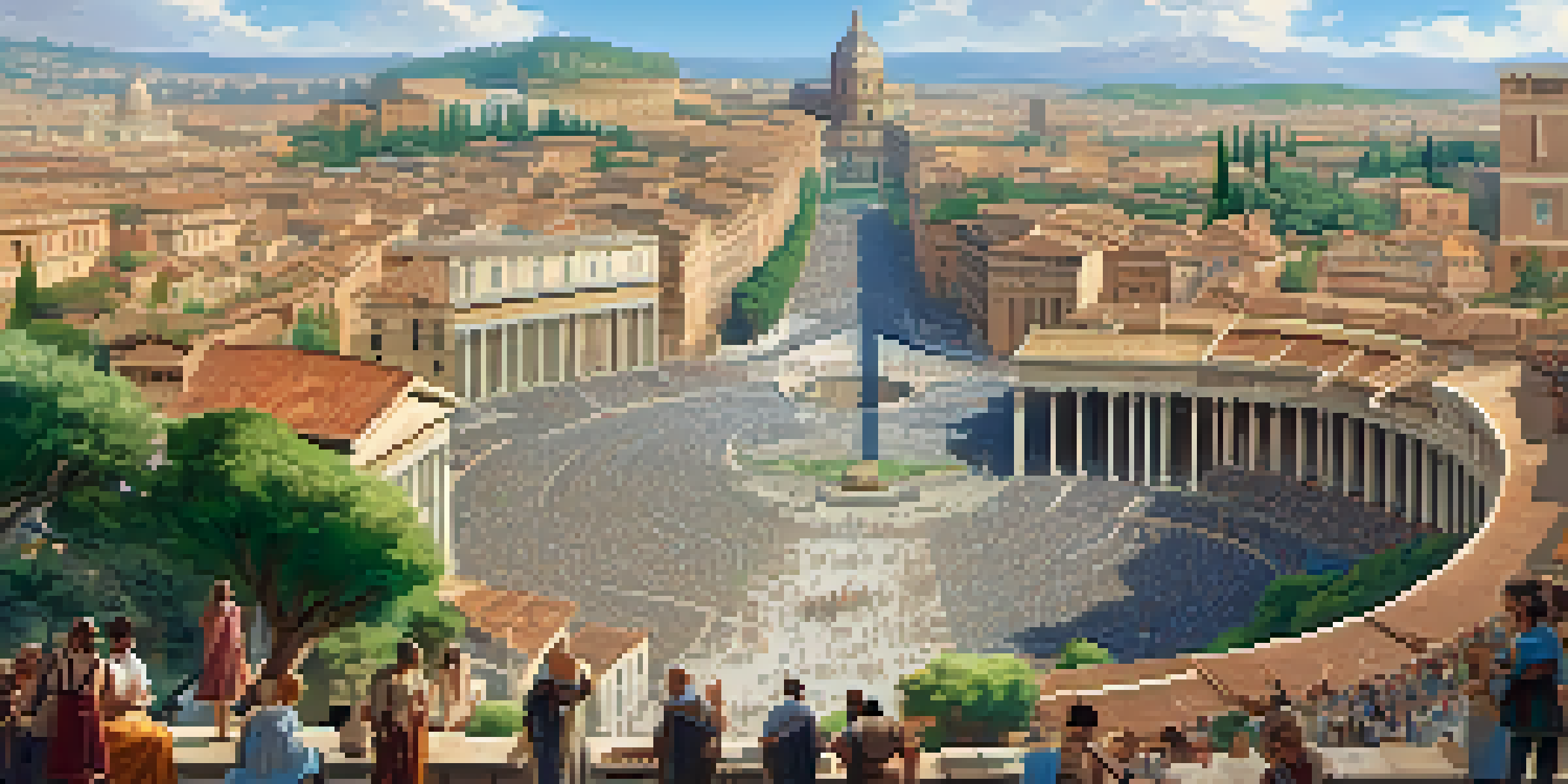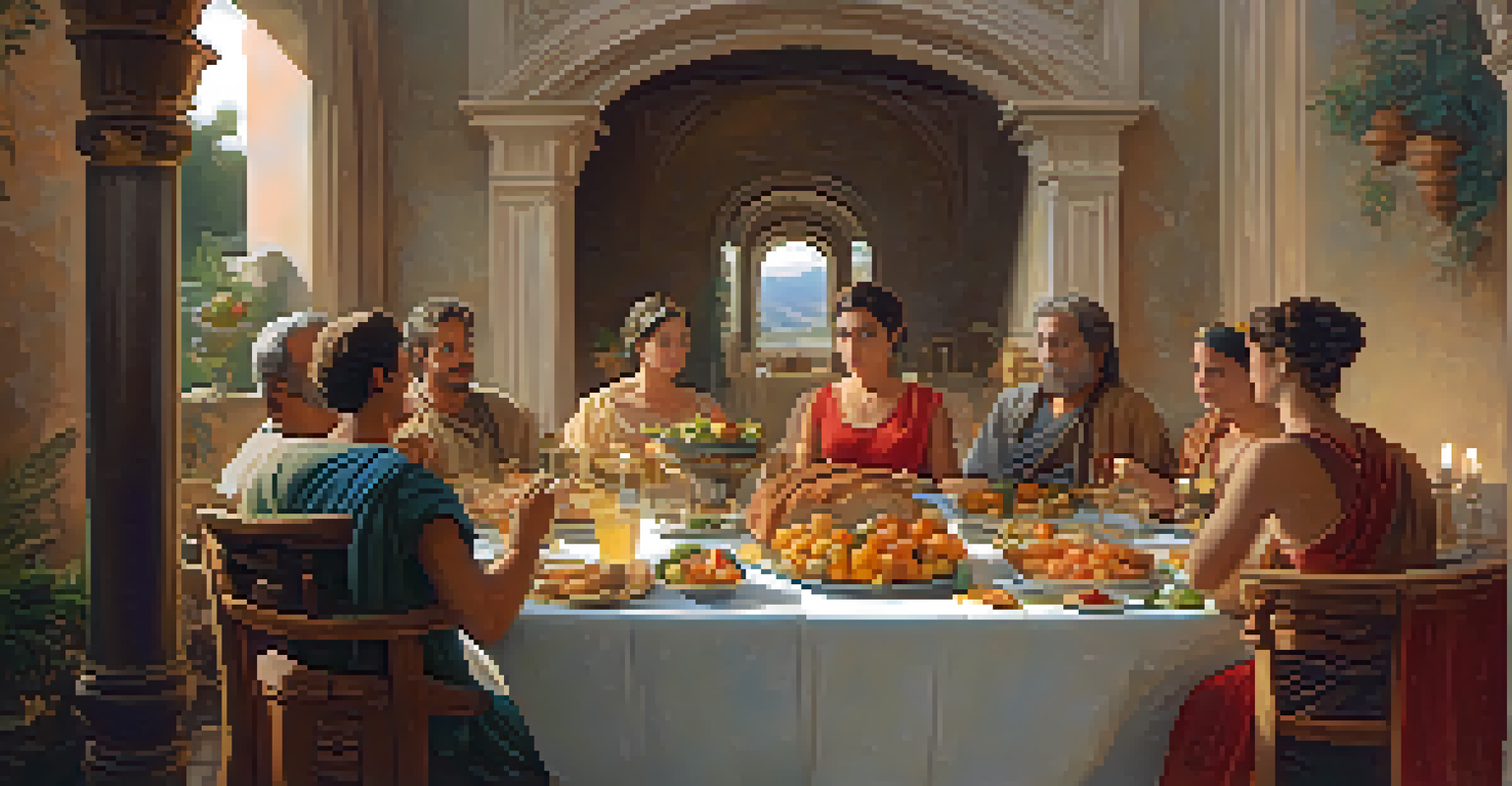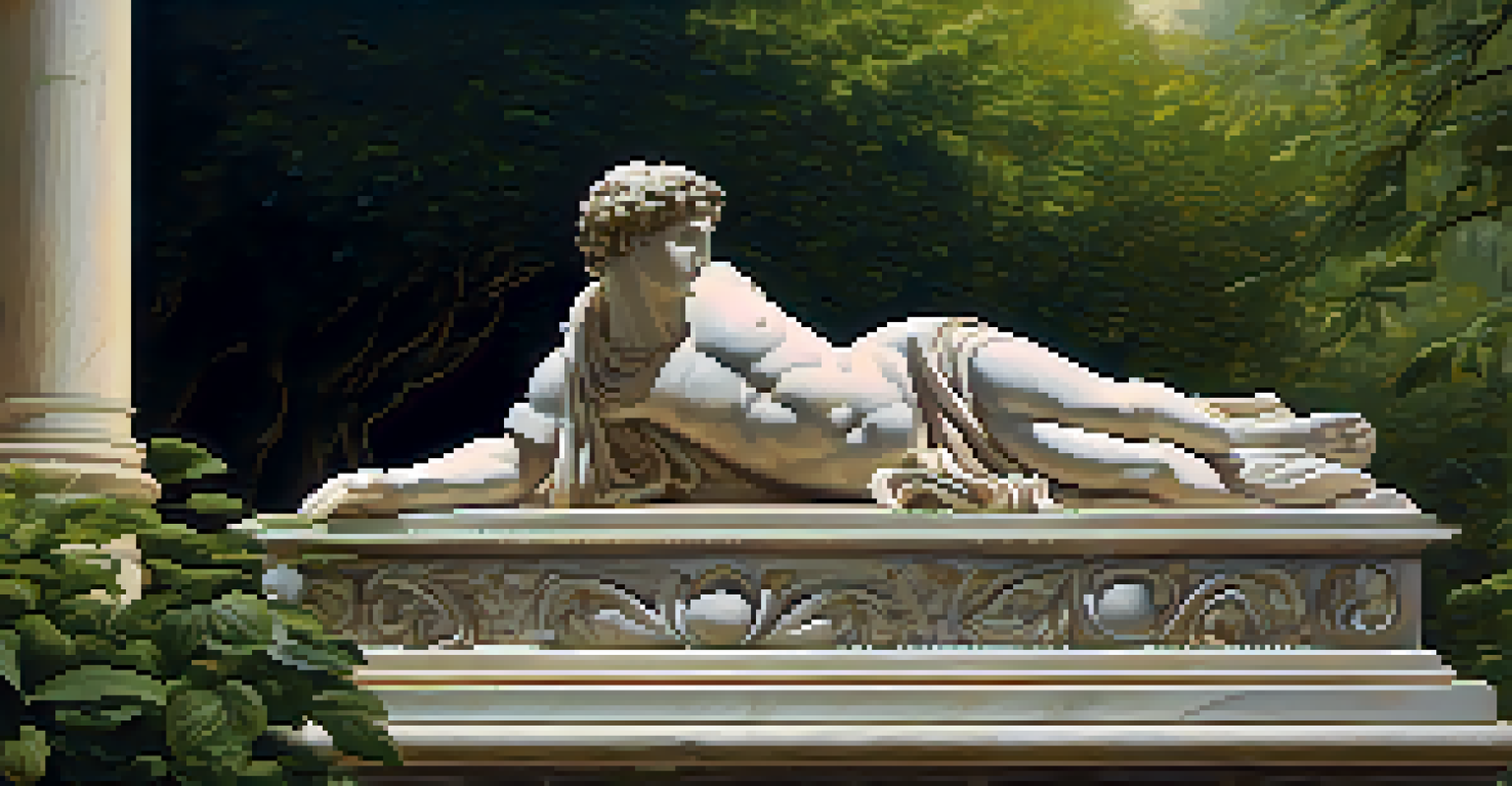Exploring Ancient Rome: A Journey Through Time and Culture

The Origins of Ancient Rome: A Historical Overview
Ancient Rome's history begins in 753 BC, traditionally marked by the founding of the city by Romulus. This legendary tale of twin brothers, Romulus and Remus, highlights the mythical roots intertwined with historical facts. As a small settlement, Rome quickly grew into a powerful city-state, laying the foundation for its eventual empire. By understanding these origins, we gain insight into the values and beliefs that shaped Roman society.
Rome wasn't built in a day.
In the early days, Rome was ruled by kings, but this changed dramatically around 509 BC when the last king was overthrown, paving the way for the Roman Republic. This shift marked a significant evolution in governance, introducing the concept of elected officials and representative democracy. The Republic era was characterized by expansion and military conquests, setting the stage for Rome's dominance in the Mediterranean region.
The transition from Republic to Empire in the first century BC brought about immense cultural and political changes. Figures like Julius Caesar and Augustus played key roles in this transformation, influencing everything from law to architecture. Recognizing these pivotal moments helps us appreciate how Ancient Rome became a cornerstone of Western civilization.
Roman Society: Class Structure and Daily Life
Roman society was distinctly hierarchical, divided mainly into three classes: patricians, plebeians, and slaves. The patricians, or aristocrats, held most of the power and wealth, while plebeians, the common people, played crucial roles in agriculture and trade. Slaves, often prisoners of war or heavily indebted individuals, formed the base of the social pyramid and their contributions were essential to the economy.

Daily life in Ancient Rome varied significantly across these classes. Patricians enjoyed luxuries such as grand villas, elaborate feasts, and access to education, while plebeians lived in more modest conditions, often in crowded apartments. Despite their differences, all classes participated in the vibrant cultural life of the city, from attending public games to visiting the bustling markets.
Rise of the Roman Republic
The transition from monarchy to the Republic in 509 BC introduced elected officials and representative democracy, shaping Roman governance.
Religion also played a vital role in Roman society, influencing daily routines and major life events. The Romans worshipped a pantheon of gods and goddesses, believing that their favor ensured prosperity. This deep connection to spirituality was evident in the many festivals and rituals that punctuated the Roman calendar, reflecting the community's values and unity.
The Architectural Marvels of Ancient Rome
Roman architecture is renowned for its grandeur and innovation, with structures like the Colosseum and Pantheon standing as testaments to their engineering prowess. The Colosseum, an iconic amphitheater, could hold thousands of spectators for gladiatorial contests and other public events. Its design, featuring arches and a complex system of vaults, showcased the Romans' ability to combine functionality with aesthetic appeal.
All roads lead to Rome.
Another architectural wonder, the Pantheon, exemplifies Roman ingenuity with its massive dome and oculus. Built as a temple for all gods, its harmonious proportions and light-filled interior create an awe-inspiring experience. The Pantheon has influenced countless buildings throughout history, serving as a model for architects in various cultures.
Roman engineering extended beyond monumental buildings; they also excelled in creating roads and aqueducts. These infrastructures facilitated trade and transportation, connecting cities across the empire. The durability of their roads, many of which still exist today, underscores the Romans' understanding of logistics and urban planning.
The Role of Religion in Ancient Roman Life
Religion in Ancient Rome was a blend of local traditions and the worship of deities from conquered territories. The Romans practiced polytheism, believing in a pantheon of gods and goddesses who governed various aspects of life. This religious diversity fostered a sense of unity among the diverse populations within the empire, as shared rituals and festivals brought people together.
The state religion was closely tied to politics, with emperors often deified and worshipped as gods. This practice reinforced the emperor's authority and the idea that their rule was divinely sanctioned. The Vestal Virgins, a group of priestesses, played a crucial role in maintaining the sacred fire of Vesta, symbolizing the stability of Rome, further intertwining religion with civic duty.
Architectural Innovations
Ancient Rome's engineering marvels, like the Colosseum and Pantheon, showcase their architectural brilliance and influence on future structures.
As the empire expanded, so did the introduction of new beliefs, including mystery religions and eventually Christianity. The rise of Christianity challenged traditional Roman values, leading to tensions and persecution. Understanding these religious dynamics offers insight into how faith shaped not only individual lives but also the broader cultural landscape of Ancient Rome.
Politics and Governance: The Roman Republic to Empire
The Roman Republic was characterized by a complex system of checks and balances, with power shared among elected officials, the Senate, and popular assemblies. This governance model aimed to prevent any single individual from becoming too powerful, a lesson drawn from their monarchical past. The Republic saw significant political reforms, including the Twelve Tables, which codified laws and protected citizens' rights.
However, the political landscape was tumultuous, marked by conflicts between patricians and plebeians. The struggles for power led to social changes, including the establishment of the Tribune of the Plebs, which empowered common citizens to voice their concerns. This evolving political framework laid the groundwork for Rome's eventual transformation into an empire.
With the rise of Augustus, the first emperor, the political system shifted dramatically, consolidating power under a single ruler. This new era, known as the Principate, ushered in a period of relative peace and stability called the Pax Romana. Understanding these political transitions helps us appreciate how Rome maintained control over its vast territories for centuries.
Cultural Contributions: Art, Literature, and Philosophy
Ancient Rome's cultural contributions are vast, influencing art, literature, and philosophy throughout history. Roman art is characterized by realism, as seen in their sculptures and mosaics that captured human emotions and daily life. This focus on realism differed from the idealized forms of Greek art, showcasing a unique Roman perspective.
Literature flourished during the Roman Empire, with writers like Virgil and Ovid creating timeless works that explored themes of heroism, love, and morality. Virgil's 'Aeneid,' for instance, not only told the story of Rome's legendary founding but also served as a source of national pride. These literary masterpieces reflect the values and aspirations of Roman society.
Decline of the Roman Empire
The gradual decline of Ancient Rome resulted from political instability, economic troubles, and external invasions, ultimately leading to its fall.
Philosophy also thrived, blending Greek influences with Roman ideas. Stoicism became particularly popular, emphasizing virtue, reason, and self-control. Thinkers like Seneca and Marcus Aurelius inspired generations with their writings on ethics and human behavior. The enduring legacy of Roman philosophy continues to resonate in contemporary thought, highlighting the depth of their intellectual contributions.
The Decline of Ancient Rome: Causes and Consequences
The decline of Ancient Rome was a gradual process influenced by a multitude of factors, including political instability, economic troubles, and external invasions. As the empire expanded, maintaining control over vast territories became increasingly challenging, leading to corruption and ineffective leadership. Civil wars and power struggles further weakened the central authority, demonstrating how fragile empires can be.
Economic decline also played a significant role, with reliance on slave labor stifling innovation and productivity. As resources dwindled, inflation soared, and trade routes became less secure, the empire faced severe financial strains. This economic turmoil made it difficult to sustain the military, leading to vulnerabilities against external threats.

The final blow came from invasions by barbarian tribes, culminating in the sack of Rome in 410 AD. This event marked a symbolic end to the Western Roman Empire, although the Eastern Roman Empire, known as the Byzantine Empire, continued for centuries. Analyzing the decline of Ancient Rome offers valuable lessons about the complexities of power, governance, and cultural resilience.